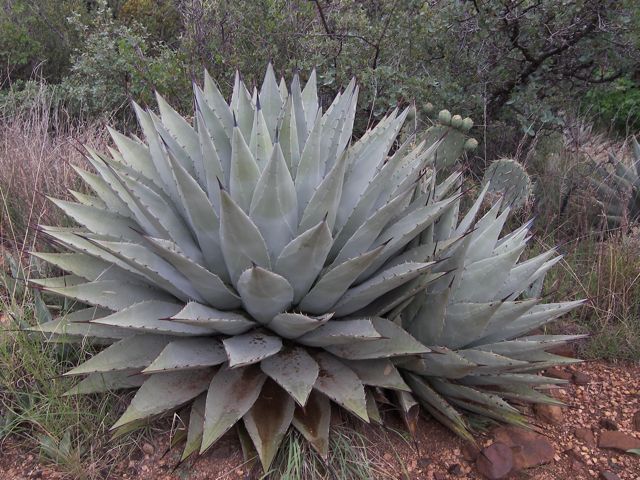 Growing Agaves - March 22, 2017 Jeff Schalau, Agent, Agriculture & Natural Resources University of Arizona Cooperative Extension, Yavapai County Agaves are attractive desert succulents that are also known as century plants. They get this name from the mistaken belief that they only flower after 100 years. In reality, the flowering cycle usually takes closer to 10 to 20 years. They produce the magnificent flowers on long stalks which attract bats, birds, and insects that also act as pollinators. To watch the agave flowering is truly amazing. The stalk begins to bolt skyward from the rosette and soon looks like an asparagus stalk. This happens so fast, you can literally watch it grow (or so it seems). Once they reach full height (up to 20 feet), the flowers open, produce fruit, seedpods open, then individual plants fade and die. The dead flower stalks are also attractive and can remain standing for one or two years. Agaves have fleshy, strap-shaped leaves with spiny or smooth margins. They form basal clumps, and on the spiny species, the exposed leaf surfaces are imprinted with the texture of the spines. Several showy species from Mexico are commonly planted in low desert landscapes. Our local native species are excellent choices for native and low water-use landscapes although you may have to search them out at specialty nurseries or botanical gardens. Agaves are in the lily family and are closely related to yucca, beargrass, and desert spoon. One Agave species, called the "shin dagger," actually looks quite a bit like a yucca. Many species of agave reproduce vegetatively as well as from seed. The vegetative "pups" appear at the base of the mother plant. Other agave species produce bulbils (plantlets) on their flowering stalks. The bulbils and pups can be removed with a sharp, clean knife and planted in a well-drained, sandy soil medium. The wounds should be allowed to dry and “scab over” for several days before planting and the soil medium should be watered infrequently to avoid rot. Agaves have also given indigenous peoples food, beverage, and fiber for thousands of years. The pit-roasted heart of the agave was an important food source to Native Americans and the rock-lined roasting pits can be found near Agave stands in the local area. Sisal comes from a Mexican species. Pulque is an intoxicating beverage made from the fermented juice of the hearts of certain agave species. Further distillation yields tequila and mescal. I've heard that mescal produces a unique euphoria. All I know is that it is an acquired taste. Most of the large agaves (rosettes 5-7 ft high and 8-12 ft across) found in landscape plantings of the low desert areas are Agave americana. These have a gray-green leaf blade, but A. americana ‘Marginata’ has creamy yellow leaf margins. Both of these are very common, but will get freeze damage when temperatures dip into the teens (degrees F). These are suitable for most areas of the Verde Valley, but the freeze damage is persistent and unattractive. Also keep in mind the large size of this plant and avoid planting it near paths, sidewalks, and other areas where it could injure passersby. Our local species are Agave parryi and Agave chrysantha. They are found in the mountains between 4,000 and 8,000 feet. Some nice stands can be seen along 89A on the slopes both above and below Jerome. Agave parryi is the hardiest agave and has a large, tight, cabbage-like rosette. A larger, more robust cousin to our local agave is Agave parryi var. Huachucensis. It is a native of southern Arizona and Sonora. Agave palmeri has a narrower leaf and more delicate flower stalk. Agave utahensis is the northernmost species and has a tall, but more compact flower stalk. Remember, these plants are protected in the wild. If you are transporting them, be prepared to show your Arizona Department of Agriculture collecting permit and have your tags attached to the plants. Otherwise, you may receive a citation. Below is additional information on agaves. Follow the Backyard Gardener on Twitter – use the link on the BYG website. If you have other gardening questions, call the Master Gardener help line in the Camp Verde office at 928-554-8992 or e-mail us at verdevalleymg@gmail.com and be sure to include your name, address and phone number. Find past Backyard Gardener columns or provide feedback at the Backyard Gardener web site: http://cals.arizona.edu/yavapai/anr/hort/byg/.  Additional Resources Cactus, Agave, Yucca, and Ocotillo University of Arizona Cooperative Extension extension.arizona.edu/sites/extension.arizona.edu/files/pubs/az1225.pdf Problems and Pests of Agave, Aloe, Cactus and Yucca University of Arizona Cooperative Extension extension.arizona.edu/sites/extension.arizona.edu/files/pubs/az1399.pdf Agave parryi Photos and Information Yavapai County Native and Naturalized Plant Database cals.arizona.edu/yavapaiplants/SpeciesDetailAgaveYucca.php?genus=Agave&species=parryi Agave chrysantha Photos and Information Yavapai County Native and Naturalized Plant Database cals.arizona.edu/yavapaiplants/SpeciesDetailAgaveYucca.php?genus=Agave&species=chrysantha |